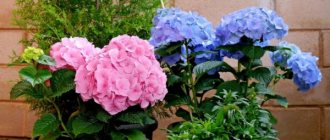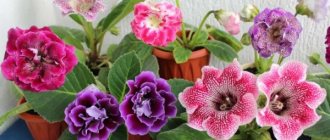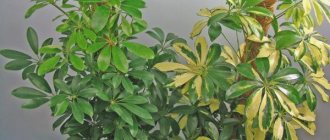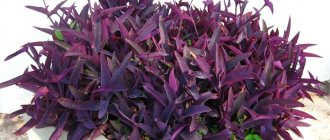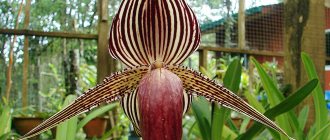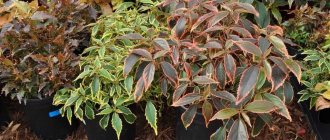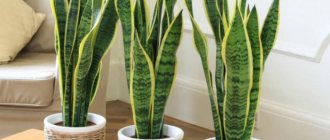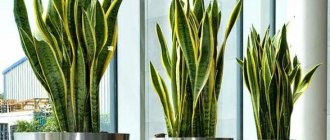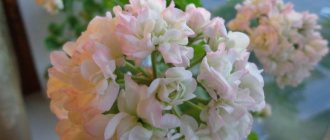Decorative akalifa is distinguished by its crimson color and oblong shape of inflorescences. With its unusual appearance and flowering, the ornamental shrub has acquired the popular name - foxtail flower. In some countries it is known as “fire cat tail” or simply “cats tails”. The beautiful name and exotic decorative appearance have won a special place in the hearts of flower growers around the world. If you also like this flower, then you should learn more about the features of growing it at home.
Briefly about care
| Type of agricultural operation for caring for akalifa | Description of conditions and actions |
| Watering and air humidity | abundant watering from spring to autumn, the flower is watered 2-3 times a week, in winter a little less often; Do not allow the soil to dry out |
| Lighting organization | diffused sunlight; Avoid exposure to direct sunlight |
| Maintaining a rest period | has no dormant period, but growth and flowering may be delayed in the winter months |
| Creating temperature conditions | stops growing at a temperature of 18 °C, the optimal temperature is from 18 to 25 °C. |
| Trimming | as needed; inflorescences and dry branches are removed |
| Making soil mixture | peat, sand, turf and leaf soil in equal proportions (1:1:1:1) |
| Fertilizer application | From March to August it is necessary to fertilize with a solution of complete mineral fertilizer |
| Transfer | young akalifa needs an annual transplant, an adult - once every 3-4 years |
| Chemical treatment | fungicides for fungal diseases and leaf spot; insecticides against spider mites, mealybugs. |
Caring for Akalifa at home
Akalifa is an overseas alien. For a long time, breeders did not domesticate it. It became indoor only in 1898. Of the 450 species, only three are found in Russian homes. What influences their growth? What conditions will have to be created?
Caring for akalifa at home involves creating a set of conditions for its comfortable growth in your garden. To do this, you need to select the necessary lighting, humidity, temperature, select fertilizing so that a motley fox tail flaunts on the window.
Growing this plant does not require any special “feats” from the grower. It is enough to water and spray the bushes in a timely manner so that they delight with panicles of bright inflorescences. In addition, regular feeding is required. How to organize care for Akalifa at home - we’ll talk in detail later in the article.
- Lighting . The flower pot is placed on a window that does not receive direct sunlight. Only the Wilks akalifa is shaded when the sun is strong.
- Temperature . At night, the optimal temperature is 15-17, and during the day – 20-25 degrees Celsius. In winter, akalifa will not disappear if the temperature is not below 16-18⁰С.
- Humidity . Wild akalifa is a resident of the tropics. It is not surprising that homemade is also picky about humidity levels. If this indicator is 30⁰ or more, you will need irrigation from a spray bottle or installing a tray under the pot with wet peat and stones.
- Soil . The ideal solution is acid support and high nutritional value. The soil mixture is made up of turf, high peat, humus and sand.
- Pot . The wider the container, the greater the chance that the bulky root system will not fill it quickly.
Reference. It blooms all year round without pause if the grower has created the right growing conditions.
Lighting and watering
Indoor akalifa prefers intense light, but it is necessary to protect its leaves from direct sunlight.
Bright light should shine on the plant at least 16 hours a day. If there are not enough natural light sources, you will have to organize artificial lighting.
Caring for akalifa requires attention to the watering procedure. This plant prefers soil with an acidic pH. When the soil becomes alkalized, the leaves become discolored, the inflorescences fall off en masse, and the plant may die. This is due to the fact that the root system of akalifa is capable of absorbing water and nutrients dissolved in it only in an acidic environment.
Therefore, approximately 5 drops of lemon juice per 1 liter of liquid should be added to water for irrigation. You can use citric acid crystals. An excellent preventative measure for alkalizing the soil is to add pine needles to the nutrient mixture during transplantation and planting. After collection, the needles should be poured with boiling water with the addition of potassium permanganate and left for 2 hours.
Temperature and humidity
During the active growth phase, the ideal temperature for akalifa will be 25 degrees. During the winter months, the room should not be colder than 18 degrees.
Proper care of any type of akalifa necessarily includes regular humidification of the surrounding air. For this purpose, you can use the most ordinary household spray bottle. Spraying is carried out 2 times a day - early in the morning and late in the evening (after sunset). You can also place trays with water nearby.
When preparing to spray foliage, fill the spray bottle with water at a temperature of 45 degrees Celsius. If this activity is not carried out, the plant suffers from gradual drying of the foliage. Bushes are easily attacked by spider mites. It will be very difficult to cope with the parasite due to the density of the foliage.
Feeding and replanting
It is recommended to replant young specimens every year, and adults - as needed (usually no more than once every three years). Akalifa is transplanted in the spring.
The soil for planting the crop should be loose, drained and breathable. For replanting, take a pot that is not very large. The soil is prepared from a mixture in equal parts:
- humus;
- sand;
- turf;
- peat
Don't forget to put good drainage at the bottom of the pot.
Akalifa is an exotic indoor plant that does not like excess nutrients. Some gardeners understand this literally, i.e. they simply deprive her of all feeding.
They risk the fact that it will die due to excessive depletion of the substrate against the backdrop of year-round flowering. To avoid the death of the plant, fertilize it.
The best time to apply fertilizer is from October to February. The optimal frequency is once every one and a half to two months. Universal and complex mineral fertilizers are used as fertilizing.
There are many different fertilizers on sale, but it is advisable to choose those that are intended for decorative deciduous and flowering plant crops. The concentration of minerals is 0.1-0.2% when applied.
Transfer
Akalifa is propagated by cuttings or seeds. Semi-lignified shoots lend themselves well to rooting in sand at 26 degrees Celsius. You can root 7-8 cm cuttings at any time.
Akalifa propagates by seeds in March-April by sowing them in a mixture of soil and sand. They should be left at a temperature of 20-22 degrees. Seedlings grow at 2-3 cm.
Let's start with the rules for rooting cuttings and planting them for subsequent growth and development. The plant propagates quite easily using aerial shoots. Cuttings up to 10 cm long are cut from an adult plant. Then they should be placed in water with the addition of succinic acid (2 tablets per 1 liter of water) for 10 days.
The soil is made up of 1 part turf soil and 2 parts organic humus. Drainage up to 1.5 cm high is laid at the bottom. Then soil is poured and cuttings are planted. In this state, they germinate until the growth of leaf mass begins. At this time, the plant can be planted in a large pot. Bushes of 3-5 cuttings should not be separated before planting. The more cuttings, the more magnificent the bush of an adult akalifa will be.
Diseases and pests
The main problems in caring for akalifa are lack of humidity, heat, nutrients and overwatering.
| Problem | Causes | How to fight | Prevention |
| Inflorescences do not form | Not enough light, heat, nutrients | • Transfer to a bright room with a temperature of 16-21 °C. • Fertilize 2 times a month | • Avoid hypothermia. • Use artificial lighting in winter. • Fertilize regularly |
| The leaves are drying up | Dry air | Trim damaged leaves | • Spray more often. • Keep a cup of water nearby |
| The leaves drooped | The soil dries out excessively between waterings | • Water well. • Cover the short plant with a plastic bag | Water regularly from March to October. |
| Healthy leaves turn pale and wither | • Overflow. • Insufficient drainage. • Soil too heavy | Replant the plant in new soil | • Use a light, loose mixture. • Do not cover the drain hole. • Water according to the season. |
| The flowers are rotting | Humidity too high | • Remove damaged flowers. • Improve ventilation in the room | • Do not spray flowers. • Ventilate the room |
| Foliage becomes covered with dark spots | Too cold or drafty | • Cut off deformed leaves. • Move to a warm room | Protect from cold and drafts |
| The leaves grow small and pale, the bush branches poorly | • Not enough nutrients. • The root system has outgrown the pot | • Fertilize the plant. • Transfer to a larger pot | Fertilize regularly from spring until the end of flowering |
| After transplantation, the young plant does not produce new shoots | The pot is too big | Transfer to a pot no larger than 13 cm | Select a pot proportional to the size of the plant |
| The two-year-old bush has a sparse crown and long internodes. | The plant is not formed | Shorten shoots to 30 cm from the soil surface | Form a bush annually at the beginning of the season |
Akalifa suffers from spider mites, whiteflies, aphids and scale insects.
| Pests | Manifestations | Struggle | Prevention |
| Whitefly | • Leaves wilt. • Greenish larvae on the bottom of the leaf blade | Treat with an insecticide (kinmix) twice a week until the whiteflies disappear | Inspect the plant and use insecticides for preventive purposes |
| Shields | • Yellowed leaves have a sticky coating. • Brown plaques | • Wipe the leaves with cotton wool and alcohol, removing pests. • Treat the plant with an insecticide (fitoverm, fufanon) | • Wash short plants in the shower. • Clean Wilks' leaves with a damp sponge. |
| Spider mite | • The leaf blade is covered with yellow spots and looks dusty. • There is a thin cobweb under the leaf | • Give the bush a shower. • Treat with acaricide (actellik). • Humidify the air around the plant | • Spray. • Wash compact plants in the shower |
| Aphid | • Leaves are curled. • Shoots are deformed | • Wash off the aphids with warm water and soap. • Treat with insecticide | Spray with insecticide for preventive purposes |
Description of the plant
Foxtail (acalipha hispida) is a tropical guest in our latitudes. The flower's homeland is Southeast Asia and Australia. The plant of the hispid variety is an ornamental-leaved and ornamental-flowering perennial shrub of the Euphorbiaceae family.
Akalifa cats tails are creeping hanging plants grown in hanging flowerpots and pots. Flower growers value the decorative features of the flower and carefully monitor the shape of the shrub.
Ornamental shrub with ovate leaves pointed at the ends. It is distinguished by earring-shaped inflorescences with a bright scarlet color, causing an association with a fox or cat's tail.
Description
A genus of beautifully flowering, evergreen shrubs; there are also herbaceous perennials and, less commonly, trees. There are about 450 plant species. Belongs to the Euphorbiaceae family. Its homeland is the tropical and subtropical forests of eastern India. The name of this genus of plant comes from the ancient Greek name nettle: by the similarity of the leaves.
There are 2 Akalifa groups:
The first is the most common: it has drooping, pointedly ovoid leaves, serrated at the edges, and bright green in color. Foxtail blooms with beautiful drooping fluffy spike-shaped inflorescences that reach a length of up to 50 cm, with a long flowering period. This group of species is grown for its beautiful inflorescences.
The second is grown for its bronze-greenish, with bright copper-red spots, ovoid, serrated at the edges, pointed foliage, reaching a length of up to 20 centimeters. The flowers are small, up to 5-10 centimeters long, red, and the flowers are collected in inflorescences.
We recommend trying to grow bamboo in your dacha.
To learn more
What you should know before buying indoor akalifa
Imagine in advance where you will place the flower. Hanging pots are most often used, since branches and flowers grow and droop profusely. If you have small children or pets, make sure the planter is out of their reach. The plant can cause health problems if it enters the stomach or mucous membranes. Read more about this below.
| Mature plant size | depending on the type from 30 to 150 cm: high (above 100 cm), low (10-50 cm), hanging (below 10 cm) |
| Lifespan | up to 7 years, but some species in indoor conditions, in order not to lose their decorative effect, it is better to update annually |
| Bloom | bright pink flowers in the form of rocking earrings; flower size from 8 to 50 cm |
| Aroma | not clearly expressed |
| Safety | poisonous; gloves are needed when working with the plant |
| Difficulty of care | quite unpretentious, but there are nuances |
| Uniqueness | rare plant |
| Where can I buy |
|
Opinions about the difficulty of caring for crops among gardeners vary. Experienced people say that the plant is very easy to grow and maintain. But for beginners, caring for a flower can bring a lot of trouble, so take this fact into account before purchasing a plant.
Varieties and photos
Since there are over 400 varieties, it is impossible to create a single accurate description of the plant: perennials, annuals, trees, shrubs, and even herbaceous crops are found in the group . But some common features are present. For example, these are flowers that delight the eye all autumn and winter: long, covered with numerous fibers. Their shade depends on the variety.
Below are photos of the main varieties of Akalifa suitable for propagation and care at home.
Wilkes (Acalypha Wilkesiana)
An evergreen shrub with a dense and lush crown that the flowers are practically invisible. Grows up to two meters in height. The stem is straight, strongly branched, covered (like the branches) with thin short hairs. The leaves are oval, with pointed tips, 5 cm wide and 13-15 cm long, slightly pubescent, covered with purple or copper veins. In the dark they take on a greenish tint, in the sun they turn orange. The flowers are unsightly. The homeland of the variety is the island of Fiji. The photo below shows Wilkes' Akalitha:
Bristle-haired (Acalypha hispida)
Under natural conditions, representatives of this variety reach a height of up to 3 meters, but under indoor growing conditions they barely reach a meter. The homeland of the bristly-haired akalifa is Polynesia. Its flowers are most often bright scarlet in color (there are also white), pubescent, reaching up to 50 cm in length. It can bloom all year round with good care. You can see what the Bristly-Hairy variety looks like in the photo below:
Bristly or rough (Acalypha hispida syn. Acalypha sanderi)
The most popular decorative type among flower growers. The stems are straight and long (up to half a meter in height), the leaves are elongated, with carved serrated edges. The inflorescences are a juicy crimson shade, and there are also snow-white specimens. It blooms all year round, the buds are collected in fluffy long inflorescences and resemble earrings. In the photo below, the variety is Bristle or Rough:
Southern (Acalypha australis)
This annual variety grows abundantly in the Far East and Caucasus and is considered a weed. It stretches up to 6-7 meters in height, but the leaves are very small - 1.5-2 cm. The shape is both lanceolate and oval, with pointed tips. The flowers are small, collected in spike-shaped or apical inflorescences. Flowering period is from July to August. The photo below shows Akalifa South:
Akalifa leaves are used by residents of Australia for medicinal purposes. Diseases of the gastrointestinal tract, pneumonia, asthma, bronchitis and other ailments of the respiratory system - akalifa helps to cope with all these problems. But the point is in phytoncides, which, secreted by the plant, cleanse the air of pathogenic bacteria.
Plant energy: can akalifa be kept in the house?
Akalifa, growing in a home flower garden, will protect household members from depression, scandals, and a melancholic mood. A flower, like a lightning rod, absorbs psycho-emotional outbursts. Negative emotions seem to be purified in a field of flowers.
If you give up and doubts prevent you from starting an important task, stand next to Akalifa and your self-doubt will pass. Prudent parents place a flower near the student’s desk. After all, among other things, the plant relieves laziness, makes a person more collected, and increases efficiency.
If you belong to the category of people “of everything and more” (which does not always have a positive effect on your health and psychological state), a green pet will help you reconsider your attitude towards life and balance the concepts of “want” and “need”.
It is not for nothing that Akalifa is called a “warm flower”, because its owner will never suffer from the cold. This is a real godsend for people who are cold or allergic to cold.
If you stay near Akalifa for at least 10 minutes a day, the functionality of internal organs will be stimulated and the general condition of the body will improve.
Attention! Do not expect the manifestation of beneficial properties and positive energy from a sick, lethargic or dried flower.
Care problems
When growing akalifa, gardeners face a lot of difficulties. Main problems:
- The appearance of wet brown spots on the leaves.
- The leaves begin to wither. This occurs due to overdrying or waterlogging of the soil.
- Pallor and loss of color. These deviations indicate a lack of light.
- The appearance of dark spots on the leaves. They appear as a result of drafts and hypothermia.
Properly selected care will avoid such problems and preserve decorative properties.
Transplanting a plant
The main difficulty is that for a tropical guest it is necessary to create suitable conditions in our climate. However, if the necessary parameters are observed, the plant develops well and pleases its owner with fiery inflorescences all year round.
With proper care and living conditions, it has no rest period. During the winter months, growth and flowering may be delayed due to short daylight hours.
The flower can be replanted in warm spring (April or May). A young flowerpot is replanted every year, an adult plant - once every 3-4 years. The substrate for replanting can be purchased in specialized stores or prepared independently by taking sand, peat, turf and leaf soil in a ratio of 1:1:1:1.
Foxtail contains a poisonous milky sap that can cause skin irritation. Therefore, when working with it, always protect your hands with gloves. Also make sure that your children and pets do not have the opportunity to come into contact with the planter.
Akalitha. Problems during cultivation.
- Akalifa stretches out, the leaves turn pale when there is insufficient lighting.
- Fading foliage, slow growth with a lack of fertilizer in the soil, emphasis on nitrogen is necessary.
- The tips of the leaves become dry in a room with dry air or with insufficient watering.
- Yellowing and falling of leaves occurs if the air in the room is too dry.
- Spotting of the foliage indicates that the plant has been infected with a fungal disease; treatment with a fungicidal preparation is necessary.
- Dark spotting appears if the plant is exposed to drafts or cold temperatures.
- Foliage wilts with too little or too much watering.
- The foliage withers and falls off if the room temperature is too low.
Views: 1,311
Temperature and light
In our latitudes, akalifa ampelous requires special care at home, which includes maintaining optimal temperature and light. Acalypha is a heat-loving plant. It must be kept indoors.
The flower does not tolerate temperature changes well, so you should not move it from place to place.
The optimal temperature is from 18 to 25 °C. It reacts painfully to the slightest drafts and stops growing at temperatures below 18 °C. When determining the location of the flowerpot in the house, it is extremely important to remember this feature.
Akalifa
Foxtail, like all tropical plants, loves bright sunlight. However, the flower easily gets burned from direct sunlight. Therefore, pots with akalifa should not be hung directly opposite the window glass. Place the flower in the brightest room in the house and hang it so that it receives indirect sunlight.
Growing rules
According to the generally accepted classification, akalifa is classified as an undemanding representative of the flora, the care of which is easy. However, you need to know the basic rules of growing in order to avoid common mistakes and get a healthy, powerful specimen.
Temperature
The temperature regime during maintenance is due to the fact that the flower comes from the tropics and subtropics. In summer, the optimal value is 20-25°C, but if the pot is taken out into the yard, onto the balcony or into the garden, then even hotter weather is tolerated normally. When the temperature in a house or apartment rises to 30°C or more, this slows down the rate of development.
The plant loves fresh air, but does not tolerate drafts. The location is selected taking this factor into account, so placing the pot near the windows for ventilation is not recommended.
In winter, you need to make sure that the room temperature is not less than 18°C, otherwise your home flower may get sick or even die. A temperature of 15°C is considered critical for the akalifa plant.
Lighting
When growing, it is necessary to provide the maximum amount of light, so location on south or south-east windows is preferable. But at midday, direct sunlight can damage the young parts of the flower not only in summer, but also in early spring, so it is better to provide shading.
In winter, there may be a lack of light. This is especially visible in the plant if the heating works well and the temperature does not drop. The lack of lighting is noticeable by thin and elongated young shoots. In this case, you can use artificial light sources: lamps or phytolamps.
Watering
Akalifa is a plant that needs good watering. Intensive watering begins after the ambient temperature rises above 20°C. Overdrying the soil is unacceptable: very quickly the leaves will lose turgor and become lethargic. If this happens, the pot must be placed in a container with water and kept there for 15-20 minutes, then removed and allowed to drain excess moisture through the drainage holes. In the cold season at moderate temperatures, watering is reduced. You should focus on the drying level of the substrate.
Both bottom and classic top watering are allowed. The water should be the same temperature as the environment. It is advisable to take softened or distilled, and the ideal option is melt or rain. Do not allow water to stagnate in the pan: this threatens to rot the roots.
Spraying
Parasites develop faster in dry air, so experts advise increasing the humidity in the room. To do this, you can use a fine sprayer or a humidifier. It is also suitable to lay out moistened moss, expanded clay or pebbles in a tray or on a substrate.
When spraying, you cannot use hard water: it will leave white spots, and this will not just spoil the appearance of the crown, but will cause the plant to feel unwell.
Feeding
Caring for indoor akalifa must include periodic fertilizers. Preference should be given to complexes for decorative deciduous trees. They begin to be introduced in early spring, as soon as the first signs of growth of new shoots are visible. For a month, use a concentration 2 times less than indicated in the instructions, and then switch to the standard one. Typically, fertilizer is applied once every 14 days.
During the cold months, it is recommended to stop feeding, but if the temperature does not change and artificial lighting is provided, you can simply reduce the frequency by 2 times. Always fertilize on wet soil, since in dry soil the mineral substances of the complex can cause stress to the root system.
Transfer
The flower is characterized by active growth, especially at a young age. To ensure that development does not stop, it is transplanted annually into a new container, which should be a couple of centimeters larger in diameter. Adult specimens can be replanted after a year. It is easiest to carry out transshipment in order to reduce trauma to the root system to a minimum.
All manipulations with this flower must be carried out with rubber gloves, since the milky sap causes burns on the skin. If juice gets in, the affected area is washed with water.
In old, large specimens, replanting can be replaced by a partial change of soil in the upper part of the container.
Priming
Main requirements for the substrate:
- good breathability;
- saturation with nutrients.
When purchased at a flower shop, primer for decorative foliage is suitable. Some amateur gardeners prefer to prepare the soil themselves. If you take the right ingredients, it will surpass the store-bought one in quality.
To do this you should prepare:
- turf soil – 3 parts;
- peat – 2 parts;
- humus - 2 parts;
- coarse sand, perlite or vermiculite - 1 part.
The mixture must be heated in the oven at 200°C for an hour to destroy parasite larvae, bacteria and fungi.
During replanting, it is important to place a 4-5 cm layer of drainage at the bottom of the pot. This is necessary to improve air exchange and remove excess liquid after watering.
Formation
To create and maintain a spectacular crown, proper pruning is necessary. Particular care should be taken in the formation of a hanging akalifa, otherwise it risks turning into an asymmetrical bare bush.
For pruning you need a sterile instrument with sharp blades.
There are 2 types of pruning:
- Sanitary - remove all damaged, dry shoots, faded flower stalks. This must be done at any time of the year when a problem is discovered.
- Formative - shorten all shoots by ½ part of the length. The event is carried out in the spring, before the start of active growth.
In addition, once every 4-5 years a radical rejuvenation is needed: all stems are cut off, leaving a bush 20 cm high. If this is not done, the base will become bare and ugly.
Watering and air humidity
It is also very important to ensure timely watering of the plant.
Foxtail loves frequent and abundant watering. The earthen clod must not be allowed to dry out.
In the summer, you need to water the flowerpot several times a week, in the afternoon, when the heat subsides. In winter - immediately after the top layer dries.
When propagating by akalifa cuttings, there is no need to water them, just spray them with warm water.
When caring for indoor plants, it is important to understand that harm can come from both a lack of water and flooding of flowers.
Green pets should only be watered with soft water. Rain, pond or river water is ideal. If this is not possible, then you need to use filtered water or obtained when the refrigerator freezes.
Tap water can also be adapted for irrigation. For this purpose, it is heated to a temperature of 50–60 °C, then left for a day in an open container. Before watering, pour the water into a clean container, as sediment remains at the bottom.
To water tropical plants, the water temperature should be 2-3 degrees above room temperature. Watering with cold water can lead to rotting of the root system and falling off of the inflorescences.
Air humidity is also important for a tropical flower. For foxtail it is no less than 50%.
Problems with maintaining a flowerpot may appear in winter, when indoor heating causes the air to become drier. To increase air humidity, using a household humidifier is indispensable. However, if you cannot get such an assistant, you can spray with soft water or use a pot with a double bottom and a peat moisturizer.
Another way to increase humidity is to group houseplants. However, in this case, there is a possibility of green pets being affected by gray mold and mutual infection from diseased plants.
Reproduction methods
Growing from seeds
Homemade akalifa can be grown from seeds. To do this, they are sown in a light and loose substrate consisting of sand and leaf soil. For the rapid emergence of seedlings, crops must be provided with an optimal temperature for growth: from 20 to 22 degrees. To maintain the required temperature and humidity, it is recommended to place the crops in a mini-greenhouse. In this case, seedlings will appear much faster.
After the plants reach a height of 20 to 30 mm, they are planted in individual cups. Then they are cared for in the same way as adult akaliphs.
Cuttings
Any type of akalifa can be propagated by cuttings. However, there is one important rule: acalypha bristly-hairy can be propagated in this way only in spring, and variegated varieties can be propagated throughout the year. For rooting, the cuttings are placed in a mini-greenhouse, and they are planted in a loose mixture of sand and peat.
Before planting for rooting, it is recommended to treat the lower part of the cutting with a product that stimulates root growth. The cutting quickly takes root and begins its intensive growth. After 6 weeks after planting the cuttings, you should pinch their upper parts so that the bushes grow more luxuriant.
How to fertilize
Plants receive nutritional minerals and organic substances from the soil through the root system. During the growth period, plants need nitrogen fertilizers, and during flowering - phosphorus and potassium fertilizers.
Micronutrient deficiency can cause the following changes:
- The leaves become pale green and gradually turn yellow. The process begins from the lower leaves, then covers the entire bush.
- The lower leaves acquire a turquoise tint, and brown or red-violet spots appear on them. Gradually this color spreads to the entire plant.
- Akalifa flowers fall off, but new ones do not appear.
- Flowers are absent or become very small.
- The plant is easily infected by fungi.
- The growth of roots and stem tips slows down.
- Young leaves curl and become crinkled to the touch.
Diseases and pests
Like any other indoor plant, akalifa can get sick and be attacked by pests. The owner’s task is to notice the signs in time and not allow the disease and pests to prevail over the houseplant.
- With a lack of light, the leaves of Akalifa noticeably become smaller and lose color, and the stems become elongated. Trim stems that are too long and move the pot closer to the window.
- If the room is too hot, the leaves begin to turn yellow and dry out. Shade the akalifa at midday or move it to another location. The reason may also be a lack of iron, so pamper the bush with a suitable fertilizer.
- Are you waiting for flowering, but it still doesn’t come? Your pet is clearly lacking something: warmth, light or nutrients.
- Akalifa stopped growing in height, and white cotton-like fluff appeared in the axils of the leaves? This is a sign of mealybug. Wash the plant under a warm shower, remove large insects with a cotton swab dipped in alcohol, and spray the rest with a solution of green soap (10-15 g per liter of water) 3 times with an interval of 7 days. If there are a lot of pests, try one of the following drugs: Fitoverm, Aktara, Calypso, Biotlin, Confidor, Mospilan.
- Aphids settle on the plant in colonies, occupying the underside of leaves, buds and shoots. Leaves behind sticky traces - a breeding ground for the development of sooty fungus. Remove damaged parts of the plant, sweep away adult specimens with a brush dipped in a solution of green or tar soap, and treat the bush with an insecticide (“Fitoverm” or “Aktellik”).
Akalifa propagation methods
Propagating indoor plants allows you to create a real home garden at a minimum cost. After all, you don’t need to spend money on a new flower or its seeds. Also, you will always find something to give to loved ones who share your passion for floriculture.
Akalifa flower can be propagated by two methods: seeds and vegetatively.
Seeds
This method is rarely used by indoor gardeners, since it requires maintaining temperature conditions and maintaining humidity in the room for 1–2 weeks.
Akalifa seeds are sown in early spring (March, April). For seed germination, a soil mixture of leaf soil and sand in a 1:1 ratio is required. Before planting, pots or boxes should be washed with boiling water and disinfected with an antiseptic solution - potassium pergamanate, 2% copper sulfate solution, formaldehyde. The soil substrate is doused with boiling water or fried.
After sowing the seeds, the pot is covered with glass or plastic film, which is lifted once a day for ventilation.
The optimal temperature for germination of akalifa seeds is 20–22 °C.
The soil should not dry out, but if this happens, it can be moistened with a spray bottle.
After the sprouts appear, they are planted in more nutritious soil with the addition of turf soil. Diving is necessary for the development of a strong root system of the plant.
Vegetatively
Akalifa is characterized by propagation by cuttings. Since propagating a flower by seeds indoors is long and difficult, most gardeners prefer vegetative propagation. For this method, parts of an already mature plant are used.
Vegetative propagation of Akalifa occurs by stem cuttings. The top of the stem with 2–3 developed leaves is cut off with a sharp knife directly below the leaf.
It is important to make sure that the cutting you cut does not have inflorescences or flower buds, otherwise the sprout will not take root.
After separation from the mother plant, the cuttings must be placed in water for 10–15 minutes. For planting, you need to prepare a substrate from a mixture of peat soil and sand (1:1).
The optimal rooting temperature for cuttings is about 20–21 °C.
An indoor greenhouse with bottom heating will help create ideal temperature conditions. Flowers grown in a greenhouse must be ventilated daily. You should not water the cuttings; instead, you should regularly spray them with warm water.
After the root system has appeared, the plant is planted in a pot using a soil composition of leaf soil, peat, turf soil and sand in a ratio of 2:1:1:1.
Akalifa bristly reproduces quickly by cuttings in spring. If the cuttings were cut at an unfavorable time of year, they should be placed in a solution of a growth stimulator before rooting. But even in this case, the rooting process will be longer.
Reproduction
Akalifa is propagated by seed and cuttings.
Seeds should be sown in early spring as follows:
- Soak the seed for a day in a solution of Epin or Zircon.
- Moisten the soil and place the seeds in it, lightly sprinkling them with soil.
- Cover the container with film and place in a warm place.
- Periodically moisten and ventilate crops.
Cuttings are also recommended to be carried out in early spring according to the following algorithm:
- Cut wood shoots 10 cm long.
- Remove the lower leaves and place the cuttings in water. The liquid level in the container should not exceed 5 cm.
- Cover the container with a bag and place in a warm, bright place.
- Spray and ventilate the cuttings every day.
- After about 2 weeks, when the roots appear, plant the akalifa in a pot with substrate.
- For seedlings at the age of 1.5 months, pinch off the upper buds so that the plant bushes.
Errors in care
Plant health problems begin with a lack of light, dry air, drying out soil, drafts and temperature changes. The depressed state of a flower can also be due to a lack of nutrients in the soil.
To determine the cause of the malaise, you need to check the plant for pests and soil moisture. You also need to remove the flower from the pot and check whether the roots are affected by parasites. If no pests are found, and the root system fills the entire bud in the pot, then the problem may be that the soil substrate is depleted and the plant needs to be replanted.
If everything is fine with the soil and roots, the problem is probably hidden in external factors. Try to compensate for the lack of lighting and air humidity.
If the plant's leaves turn yellow and fall off, the problem may be insufficient watering, low temperatures or drafts. Poor lighting or excess mineral fertilizers can be suspected of the disappearance of flowering. Flowers quickly wither due to dry air, lack of light or too high air temperature. Akalifa is also susceptible to fungal and bacterial infections.
You can visually evaluate the results of caring for an akalifa flower at home using a photo of the flower on the Internet. Healthy shrubs have a neat decorative shape, lush green leaves and bright scarlet spikelets of inflorescences.
Pests often cause pathological changes in the life of Akalifa bristlecone:
- Spider mites live on the upper and lower sides of leaves, shoots and branches. Leaves begin to fall prematurely. A thin transparent cobweb appears between the stems. Increased temperature and dry indoor air are favorable for the appearance of ticks. If the damage is minor, wash the leaves and stems thoroughly with soap and water. In case of severe infestation, treatment with insecticides or colloidal sulfur is necessary.
- Scale insects live in colonies on the underside of leaves, in leaf axils, on branches and young shoots. Parasites suck out the juice, causing the shoots to lag behind in growth, the leaves turn yellow and fall off. For mild damage, wipe the plant with a cotton pad soaked in soap, alcohol or kerosene solution. If significant, spray with insecticides.
Most popular types
Akalifa is bristly-hairy. Plants of this species were among the first to be grown at home. A bush with bright green leaves and large fluffy flowers of scarlet or crimson color. The selection hybrid stands out for its snow-white flowers. Akalifa Wilkes. The bush is decorated by unusual leaves with long and wide plates of a bronze hue, covered with spots of copper or pink-red color. They grow on shoots of a copper-red hue, covered with fibers. The inflorescences are small, up to 8-10 cm.
Akalifa Indian. The maximum height of the bush is 50 cm. It branches weakly. The leaves are small with five distinct veins at the base. Inflorescences are located in the axils of the leaves. The flowering period is short.
Akalifa oakleaf or Haitian. A small shrub with small heart-shaped leaves of a light green hue. The maximum length of inflorescences is 10 cm. When grown in a wide container, it covers the soil with a continuous carpet.
Akalifa Californian. A bush with bright pink inflorescences and light green jagged leaves.
Expert opinion on Akalifa from Anna Primatova
Well-known blogger and experienced florist Anna Primatova from the Irkutsk region, the village of Yurty, Taishet district, shares her experience in selecting soil and replanting Akalifa foxtail hairy. Anna is an agronomist by training with a specialization in biotechnology and has been growing flowers for a very long time.
Akalifa bristle-haired
Having extensive experience, the expert insists on choosing acidic, moisture-absorbing soil and, to demonstrate replanting, chose loose peat soil with Ph 2.5. A plant from a pot 9 cm in diameter is transferred to an 11 cm container. A larger volume is not recommended and the author focuses on large drainage holes.
Akalifa pot
As you can see in the photo below, the plant has a very thin and sensitive root system, so it should be remembered that overdrying is detrimental to this species. Before replanting, you can remove the top layer of dry soil and lightly massage the roots below. However, be careful not to damage the root system, otherwise the flower will dry out the leaves.
Akalifa root system
Next, without a drainage layer, the grower places the root of the plant in the prepared pot and fills it with new soil. This method is called transplantation by transshipment method.
The expert informs that the bristle-haired type of Akalifa blooms all year round and does not require a dormant period. Therefore, you can cut a plant at any time, but you should wait for new shoots. Immediately after moving the plant, pruning cannot be done, as the plant must adapt and grow.
Akalifa transplant
After the transshipment procedure, Anna recommends placing the flowerpot in a warm place. The plant does not tolerate drafts.
For proper care, it is recommended to fertilize in spring and summer, regular watering, and remove faded tails that grow back. The fertilizer must contain nitrogen.
Akalifa flowering
Anna uses vermiculite and the greenhouse effect to root cuttings. The most favorable temperature for rooting is 20-25 °C and not lower than 15 °C. The expert states that Akalifa can be considered an unpretentious plant, if you take into account all the nuances of its content.
Possible problems
Flower growers classify akalifa as undemanding plants, but sometimes you may encounter certain problems when growing them. As a rule, they arise from incorrect care.
Most often, signs of unsatisfactory condition are:
- Dull foliage. This can be either insufficient watering or excessive overwatering. It is recommended to check how dry the substrate inside the pot is before moistening.
- Falling leaves. In most cases it is caused by drafts. It is enough to move the akalifa to a more suitable place, and the crown will soon recover.
- Fading of leaf plates. This indicates a lack of nitrogen. Most often, the problem arises among those who neglect the application of fertilizing, especially the nitrogen component.
- Development stops in the warm season. It is associated either with heat or with a lack of fertilizer in care.
- Brown spots on leaf blades. For species in which the coloring does not imply such coloring, this indicates a fungal disease. At the first signs, it is necessary to remove the affected areas, and treat the rest of the crown generously with antifungal drugs. Treatments are repeated 3-5 times every 10 days.
- Presence of insects. To get rid of it, several treatments with an insecticide should be carried out.
If you take into account all these recommendations, growing and caring for akalifa will bring amazing results.
Diversity of the Akalifa family
Akalifa belongs to the Euphorbiaceae family. Akalifa foxtail is just one of the varieties of this wonderful plant. Fox tail is a plant with long scarlet inflorescences, which includes acalypha hispida.
Akalifa bristle-haired or Fox tail (acalypha hispida)
Botanists count more than 400 varieties of plants of the akalipha family, among which there are ornamental, herbaceous plants, shrubs and even trees. Some species of akalifa are classified as endangered species.
Plantarium acalypha includes the following species:
Akalifa Wilkes or Akalifa Wilkesiana (acalypha wilkesiana)
Akalifa tricolor (acalypha tricolor)
Akalifa Thai snow Akalifa Viginsi Akalifa Haitian (acalypha chamaedrifolia)
Akalifa Alba (acalypha alba) Akalifa Indian (acalypha indica)
Acalypha godseffiana
Southern acalypha (acalypha australis)
White acalypha (acalypha hispida white margined)
Not all plants have decorative value, so the herbaceous southern acalypha is a weed. Flowering ampel plant varieties, as well as variegated acalyphs, are most valued by flower growers and gardeners.
| Classification of species | Name |
| Herbaceous | southern |
| Bush | Wilksa, Indian, Godsefa, Australian |
| Ampelous | Haitian, oakleaf, Alpha Alba, bristly-haired, Thai snow |
| Tree-like | Vilkisyan |
| Variegated | wilkesiana, tricolor, variegata, musaica |
In our latitudes, they prefer to breed mainly indoor varieties, but in warmer countries, garden akalifa is common. A garden plant is grown as a bush or ornamental tree.
| Most popular types | bristly hairy; Alpha Alba; Wilks; wilkesiana; tricolor; variegata; musaica |
| Edible species | indica; kiliyata; bipartite |
Some plant varieties have medicinal properties. In medicine, the poisonous milky juice of akalifa has found application in the treatment of skin diseases, seizures and rheumatism.
Among popular signs and superstitions, there is an opinion that akalifa has positive energy and helps fight despondency and pessimism. The fiery color of the flowers will give the owner of the ornamental plant warmth on a physical and spiritual level.
Foxtail - symbolizes harmony and inner stability. Signs say that in a house with a healthy flower, men become more self-confident, and women become calm and loving.
Types of akalifa with photos and names
In Europe, the plant has been cultivated since the end of the 19th century. More than 400 wild relatives of Akalifa have been discovered and described, but no more than 4 varieties are used in indoor floriculture. The most popular are 2 types:
- Acalypha bristle-haired (A. hispida), nicknamed “Fox Tail” for its long hanging spike-shaped inflorescences of small, rich crimson flowers. This is a spreading perennial bush that grows up to one and a half meters. The jagged, slightly hairy green leaves are unremarkable.
Akalifa bristle-haired has an ampelous variety - Akalifa oak-leaved (A. chamaedrifolia), or Haitian (A. hispaniolae), with small light green leaves decorated with a grayish border. The fluffy red inflorescences are shorter than those of foxtail. Haitian akalifa is used as a ground cover plant, including for decorating the garden as an annual crop.
- Wilkes's Acalypha (A. wilkesiana), or "Copper Leaf", prized for its rounded leaves of a bronze hue with purple spots. This species also grows over time into a tall bush, although there are also miniature varieties. The flowers are sparse, reddish; unlike the showy leaves, they are not a source of pride for this species.
- But southern Akalifa (A. australis) was less fortunate. This slender, nettle-like annual is not much appreciated by gardeners. It is found in Japan, South America, and the Pacific Islands and is considered a weed.
- Akalifa Godsefa (A. Godseffiana) is decorated with elongated lanceolate leaves of a bronze-red hue, with a pink or white border. She has graceful, but not very expressive pale flowers.
- Indian Akalifa (A. indica) is a half-meter-tall annual bush that weakly branches. The serrated oval leaves are a deep malachite green. This species blooms in the second half of summer with modest axillary spikelets.
Outwardly completely different species need the same conditions for healthy growth.
The healing properties of akalifa
In 1856, Dr. Tonere tested the effects of the plant on himself and officially introduced Acalipha indica into homeopathy. Now the specific alkaloids and glycosides contained in Indian Akalifa are widely used by pharmacists. They are used to produce medicines for bronchitis, pneumonia, and bronchial asthma.
Since the 19th century, potions based on the shrub have been used as an emetic and expectorant. And Malaysians brew Akalifa as tea, and prepare decoctions from the roots and leaves to improve intestinal function. But their experiments should not be repeated - the poisonous plant is not suitable for making home remedies.
Akalifa is a very beautiful and original flowering shrub. Its inflorescences delight the eye with fluffy scarlet tails. The flowerpot is not very whimsical in cultivation. The main thing is to create suitable conditions for it. In return, the plant will delight you with bright blooms all year round.
